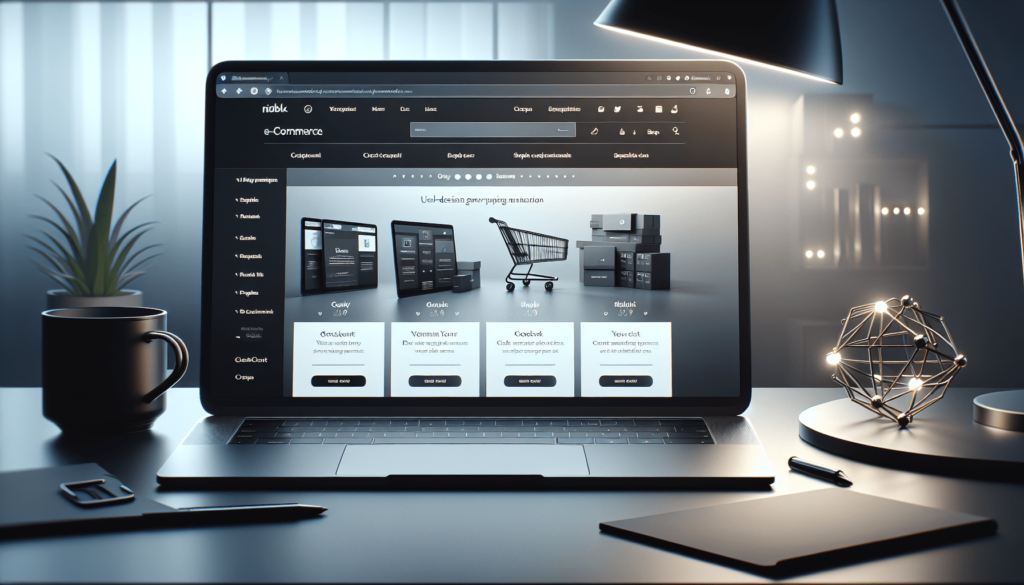Welcome to the ultimate guide on the essential elements of effective e-commerce website design! In today’s digital age, having a well-designed website is crucial for the success of any online business. From user-friendly navigation to visually appealing layouts, this article will cover everything you need to know to create a successful online store. So sit back, relax, and let us guide you through the key elements that will help your e-commerce website thrive. Have you ever wondered what makes some e-commerce websites more successful than others? The secret lies in effective website design that is focused on providing a seamless user experience. In this comprehensive guide, we will walk you through the essential elements of effective e-commerce website design to help you create a successful online store that drives sales and customer engagement.

Understanding the Importance of E-commerce Website Design
When it comes to running a successful online business, the design of your e-commerce website plays a crucial role in attracting customers and convincing them to make a purchase. A well-designed e-commerce website not only looks visually appealing but also enhances usability and functionality, which ultimately leads to higher conversion rates and customer satisfaction.
Why is E-commerce Website Design Important?
The design of your e-commerce website is the first thing that visitors notice when they land on your site. A visually appealing and user-friendly design can make a positive first impression and create a sense of credibility and trustworthiness. On the other hand, a poorly designed website can drive potential customers away and harm your brand reputation.
Key Elements of Effective E-commerce Website Design
To create a successful e-commerce website that drives sales and engages customers, it is essential to incorporate key design elements that enhance usability, functionality, and overall user experience. Let’s take a look at some of the essential elements of effective e-commerce website design.
Responsive Design
In today’s digital age, more and more people are using mobile devices to browse and shop online. A responsive design ensures that your e-commerce website adapts to various screen sizes and devices, providing a seamless and consistent user experience across all platforms. By having a mobile-friendly website, you can reach a larger audience and improve user engagement and conversion rates.
Intuitive Navigation
One of the key elements of effective e-commerce website design is intuitive navigation that helps users easily find what they are looking for. A clear and well-organized navigation menu with categories, subcategories, and filters can make it easy for visitors to browse products, explore different sections of the site, and make a purchase without any confusion.
High-Quality Images and Visuals
Visual content plays a significant role in attracting and engaging customers on an e-commerce website. High-quality images and visuals of products can showcase their features and details, allowing customers to make informed purchasing decisions. By investing in professional product photography and visuals, you can enhance the overall look and feel of your website and create a visually compelling shopping experience for visitors.
Clear Call-to-Action Buttons
A call-to-action (CTA) button is a crucial element of effective e-commerce website design that prompts users to take a specific action, such as making a purchase, signing up for a newsletter, or adding a product to the cart. Clear and prominently placed CTAs help drive conversions and guide users through the buying process, making it easier for them to complete a transaction.
User-Friendly Checkout Process
The checkout process is the final step in the customer’s journey on an e-commerce website, and it is essential to make it as seamless and user-friendly as possible. A simplified checkout process with minimal steps, clear instructions, and multiple payment options can reduce shopping cart abandonment rates and increase conversions. By optimizing the checkout process, you can create a frictionless shopping experience that encourages customers to complete their purchase.
Trust Signals and Security Features
Building trust with customers is crucial for the success of an e-commerce website. Trust signals such as customer reviews, testimonials, trust badges, and secure payment gateways can reassure customers that their personal information is safe and that they are making a secure transaction. By incorporating trust signals and security features into your website design, you can instill confidence in shoppers and increase their trust in your brand.

Best Practices for E-commerce Website Design
In addition to incorporating essential elements into your e-commerce website design, it is essential to follow best practices that can help optimize the overall user experience and drive conversions. Here are some best practices for e-commerce website design that you should consider implementing:
Minimize Load Times
Slow loading times can significantly impact the user experience and lead to high bounce rates on an e-commerce website. To improve website performance, optimize images, use a content delivery network (CDN), minimize HTTP requests, and enable browser caching. By reducing load times, you can create a faster and more responsive website that keeps users engaged and encourages them to explore your products.
Implement User-Friendly Search Functionality
An advanced search feature with filters, sorting options, and autocomplete suggestions can help users quickly find what they are looking for on an e-commerce website. By implementing user-friendly search functionality, you can enhance the browsing experience, increase product discoverability, and help users easily navigate through your site. Additionally, tracking search queries and analyzing user behavior can provide valuable insights for improving product recommendations and enhancing the overall user experience.
Optimize Product Pages
Product pages are the heart of an e-commerce website, and it is essential to optimize them for conversions. Include high-quality images, detailed product descriptions, pricing information, customer reviews, and related products to provide users with all the information they need to make a purchase decision. By optimizing product pages, you can create a compelling shopping experience that increases user engagement and drives sales.
Personalize the Shopping Experience
Personalization is a powerful tool for enhancing the user experience and driving customer loyalty on an e-commerce website. Use data-driven insights and analytics to personalize product recommendations, promotional offers, and email marketing campaigns based on user preferences, browsing history, and purchase behavior. By personalizing the shopping experience, you can create a more tailored and relevant experience for customers that increases engagement and encourages repeat purchases.
A/B Testing and Optimization
Continuous testing and optimization are essential for improving the performance of an e-commerce website and increasing conversions. Implement A/B testing for different design elements, CTAs, landing pages, and product recommendations to identify what works best for your audience. By analyzing user data, monitoring key performance metrics, and making data-driven decisions, you can optimize the user experience and maximize the impact of your website design on sales and revenue.

Conclusion: Creating a Successful E-commerce Website Design
In conclusion, effective e-commerce website design is a critical factor in attracting customers, driving sales, and building a successful online business. By incorporating essential elements such as responsive design, intuitive navigation, high-quality images, and clear CTAs, you can create a visually appealing and user-friendly website that enhances the overall shopping experience for visitors. Additionally, following best practices for e-commerce website design, such as minimizing load times, optimizing product pages, personalizing the shopping experience, and conducting A/B testing, can help optimize website performance and increase conversions. By focusing on creating a seamless user experience and prioritizing customer satisfaction, you can create a successful e-commerce website that drives sales and customer engagement.

